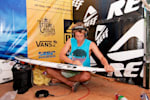A surfing wipeout can be incalculable and hostile. It is the last thing you want to encounter when surfing.
However, there’s no way to prevent getting wiped out. You should think of how to respond wipeouts rather than avoiding them.
Always remember that when surfing a shallow break, there’s no room for panics.
The best way to deal with it is always to get ready and minimize the possible accidents it may cause.
Additionally, scanning through the following tips is also a great way to keep ahead of the angry waves as you surf; hence, they wouldn’t wipe you out.
1. Don’t Panic
Panic usually accompanies the feeling of helplessness. However, panicking is the worst reaction you shouldn’t do when the waves are sucking you in.
No matter what happens, stay calm.
When you are under stress, your body will consume more oxygen. When trapped under waves and underwater, make sure to get a hold of yourself to retain your air supply a bit longer.

2. Jump Off From Your Board
Immediately jump towards the wave or away from your board when you realize that you are about to fall.
Make sure to jump as far as away from your board.
However, do not ever jump and land in front of your board. Otherwise, you might hit your head.
If this happens, use your hands to cover your head from the board.
3. Jump as You Would in Shallow Waters
If you are about to fall from your board, try to jump as if you would be springing in shallow water or pool that only have a bottom of a couple of feet down (0.6 meters).
If you would jump as you would do in deep water, you might cut yourself against the reefs, hit the seabed hard, or sprain your ankle from the force.

4. Go Butt First
When imagining to jump off in shallow waters after realizing you’ll be wiped out, go butt first as if you will be doing a cannonball jump.
When you’re going to bend your legs, you’re minimizing the chances of spraining your ankles from hitting the seafloor hard.
Whatever position you do, make sure you will never go head first.
5. Cover Your Head
You will rarely see someone who will wear a helmet while surfing.
However, one thing is for sure. Your head is one of the most important and fragile parts of your body.
So if things went wrong, like being wiped out, you should immediately protect and cover your head with your arms.
6. Get Low
It’s calmer when you’re on the ocean floor.
Let yourself to get sink under the water and expect that the angry waves will easily and simply pass above you.
However, needless to say, you should always assess the bottom before going into the water to know what you expect.
Can’t think anymore when in emergencies? Then, learn the area first before surfing.

7. Come Out Cautiously
When you’re at the bottom, slowly come out from the water and cover your head.
While you want to get back up as soon as possible because you’re out of breath, make sure you’re cautious on the things above you.
Your board or other surfers on their board maybe just above you.
Coming out on the spur of the moment causes accidents, and you might end up getting nasty cuts and bruises.
8. Control Your Board
Grab your board back and paddle away as soon you’ll get in the surface above water.
Don’t ever leave it floating on the other side of your leash. Otherwise, it might hit you back because of the currents or other surfers might be hurt from it.

How to Decrease the Chances of Getting Wiped Out and Injured While Underwater?
The first thing you should consider is not paddling out in places where you are not good at.
Always keep these two words in mind: play safe.
To be specific, don’t surf on places outside your comfort zone and paddle through waves that are way beyond your limit.
Unless you want to get badly hurt, don’t do it.
Second is to always check your surroundings – assess the conditions before you get into the water.
Be aware of the spots where underwater rocks, razor-sharp reefs, and rip currents are located.
If the surf spot has a sharp reef, take note and be careful of the cracks and edges that might cut your ankles.
You may only push yourself out as long as the surf spot’s bottom is sandy.
The next thing you should do is to be patient – observe the waves and take some time to know the right timing.

Also, don’t surf in one wave in the same direction and at the same time as the other surfers.
Ultimately, be patient in building up and recovering your muscles before going to surf again. Bulk up in a healthy way.
Check some creatine supplement recommendations. This substance is naturally found in muscle cells and is known to improve strength, increase muscle mass, and boost muscle recovery.
The Takeaway
You might be trembling, either physically or mentally, after being held down by a few never-ending sets of waves and got a personal interaction with many coral reefs.
This doesn’t mean you shouldn’t worry. You should. However, it’s important to stress that even the best among the best surfers would feel that way.
Although it sounds scary, this is not meant to frighten you. This is one way to enlighten you on how to overcome surfing wipeout.
You should expect bad things will happen since we’re talking about an extreme sport here.
If you’re hurt, be strong physically and mentally first before indulging again to surfing. While on rest, ponder about the things you did well as well as those you did wrongly.
Remember that success is not final, nor failure is fatal. It is the courage to continue that counts.





Recent Comments